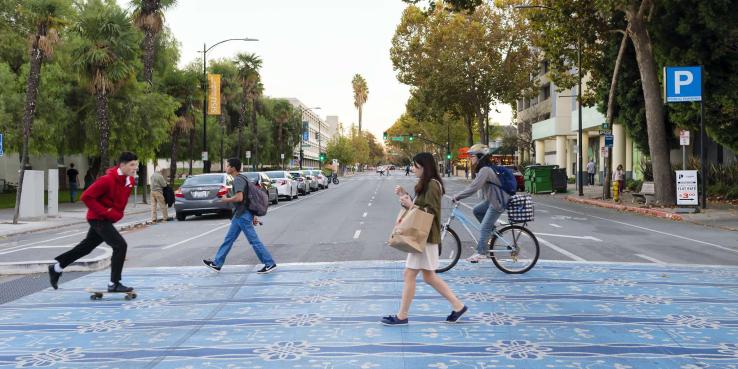Every four years, the City of San Jose has the opportunity to review and update selected elements of its general plan. Adopted in 2011, Envision San Jose 2040 is deeply important to the future of San Jose, laying out an urban vision for the Bay Area’s largest city. Envision 2040 has set progressive and aspirational goals for San Jose around housing, transportation and resiliency. It has also earned recognition and awards for its extensive community engagement process and interdepartmental collaboration to develop long-range goals and policy recommendations.
Since the last four-year review, in 2015, the city has seen incredible demand for commercial and residential development driven by both the private and public sectors. The trends and forces that will impact San Jose over the next decade require the community to think comprehensively when it comes to this next general plan update. With the announcement of Google’s expansion to downtown San Jose, the Beryessa BART station on the cusp of opening and the electrification of Caltrain and extension of high-speed rail both underway, San Jose is bound for great change. Now is the time to update Envision 2040 to better accommodate and respond to this level of investment and growth.
On June 25, City of San Jose staff members presented a proposed scope of work for the four-year review. The scope of work indicates the only items of the general plan that will be analyzed by staff, consultants and the General Plan Task Force this time around. We were pleased to see that the items proposed were chosen thoughtfully and in response to both community feedback and market forces. SPUR supported the proposed items and proposed several additional items for the task force to consider during the review period.
Among the items proposed by staff members and the City Council, a few themes emerged: affordable housing needs, the number of planned jobs, the future of North Coyote Valley, the city’s goals for its ratio of jobs to employed residents, implementation of the city’s urban village strategy and environment indicators, including greenhouse gas reduction.
Addressing the Housing Crisis
Several items in the adopted scope address housing production and process, with a special focus on urban villages — designated growth areas where the city plans to concentrate new development. Below are a few of the items that will be analyzed and considered:
- Some redistribution of planned jobs and housing growth within urban villages, which may include adjusting urban village boundaries, removing certain urban villages or adding new urban villages
- Flexibility on the number of housing units allowed per parcel based on lot size, location and other factors
- Allowing mixed-income housing within mixed-use developments
- Allowing single-family parcels that are near transit-oriented urban villages or adjacent to existing medium-density buildings to redevelop with 2 to 4 units per parcel
- Exploring policies that would allow limited housing in neighborhood business districts
- Shifting urban villages that are currently planned for a future phase or “horizon” into the current planning horizon
- Modify the policy for “signature projects” (projects that exceed jobs and housing targets and are allowed to move forward ahead of the regular planning process) to establish more appropriate and clear requirements for residential and commercial densities
Securing the Future of Coyote Valley
The history of land use in Coyote Valley is long and complex. North Coyote Valley today is primarily open space and agricultural land, but dating back to 1984, much of the area has been designated for business and industrial uses. Developers in the late ’80s and ’90s had expansive plans for developing corporate campuses for Apple and Cisco Systems. However, with the recession and trends in development, none of those plans were realized. Fast forward to 2018, when San Jose voters passed Measure T, approving a $650 million general obligation bond for disaster preparedness, public safety and infrastructure. Measure T authorized the use of bond funds for “preventing flooding and water quality contamination, including the acquisition of open space in Coyote Valley for these purposes.” The current language in the general plan reinforces North Coyote Valley as a location for jobs, but given the trends mentioned, the City Council approved review and analysis of the following:
- The potential redistribution of jobs capacity from North Coyote Valley to other general plan growth areas
- Possible fiscal and other effects on the City of San Jose that could occur with the loss of employment land in North Coyote Valley
- the long-term future of North Coyote Valley and the Mid-Coyote Urban Reserve considering key city objectives such as the preservation of open space and wildlife habitat, flood and groundwater protection, agriculture, climate change resilience and passive recreation
SPUR supports this decision and has advocated for a move away from the current focus on commercial and industrial uses in Coyote Valley.
Reducing Greenhouse Gases
San Jose has set a progressive goal to reduce its number of vehicle miles traveled (VMT) by 40%. Vehicle miles traveled measures the distance a vehicle travels to a destination, divided by the number of passengers — a key metric for reducing energy consumption and greenhouse gas emissions. The general plan created a three-tier approach for achieving its transportation goals; currently only tier one has been made effective. The review will request that the City Council allow the plan to move to tier two of the strategy to further achieve its goals in making San Jose a healthier and more resilient community.
The General Plan Task Force will convene in November to kick off the review process. SPUR will serve as a co-chair of the task force and will help to lead and inform the future of this plan. Throughout the review, SPUR will be researching and making design and policy recommendations to inform the conversation. Additionally, we will host several public forums on the general plan review this fall.
